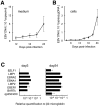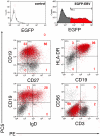Replication of Epstein-Barr virus primary infection in human tonsil tissue explants
- PMID: 21998663
- PMCID: PMC3187765
- DOI: 10.1371/journal.pone.0025490
Replication of Epstein-Barr virus primary infection in human tonsil tissue explants
Abstract
Epstein-Barr virus (EBV) may cause a variety of virus-associated diseases, but no antiviral agents have yet been developed against this virus. Animal models are thus indispensable for the pathological analysis of EBV-related infections and the elucidation of therapeutic methods. To establish a model system for the study of EBV infection, we tested the ability of B95-8 virus and recombinant EBV expressing enhanced green fluorescent protein (EGFP) to replicate in human lymphoid tissue. Human tonsil tissues that had been surgically removed during routine tonsillectomy were sectioned into small blocks and placed on top of collagen sponge gels in culture medium at the air-interface, then a cell-free viral suspension was directly applied to the top of each tissue block. Increasing levels of EBV DNA in culture medium were observed after 12-15 days through 24 days post-infection in tissue models infected with B95-8 and EGFP-EBV. Expression levels of eight EBV-associated genes in cells collected from culture medium were increased during culture. EBV-encoded small RNA-positive cells were detected in the interfollicular areas in paraffin-embedded sections. Flow cytometric analyses revealed that most EGFP(+) cells were CD3(-) CD56(-) CD19(+) HLA-DR(+), and represented both naïve (immunoglobulin D(+)) and memory (CD27(+)) B cells. Moreover, EBV replication in this model was suppressed by acyclovir treatment in a dose-dependent manner. These data suggest that this model has potential for use in the pathological analysis of local tissues at the time of primary infection, as well as for screening novel antiviral agents.
Conflict of interest statement
Figures






Similar articles
-
Efficient replication of Epstein-Barr virus in stratified epithelium in vitro.Proc Natl Acad Sci U S A. 2014 Nov 18;111(46):16544-9. doi: 10.1073/pnas.1400818111. Epub 2014 Oct 13. Proc Natl Acad Sci U S A. 2014. PMID: 25313069 Free PMC article.
-
Detection of lymphocytes productively infected with Epstein-Barr virus in non-neoplastic tonsils.J Gen Virol. 2000 May;81(Pt 5):1211-6. doi: 10.1099/0022-1317-81-5-1211. J Gen Virol. 2000. PMID: 10769062
-
Inhibition of Epstein-Barr Virus Replication in Human Papillomavirus-Immortalized Keratinocytes.J Virol. 2019 Jan 4;93(2):e01216-18. doi: 10.1128/JVI.01216-18. Print 2019 Jan 15. J Virol. 2019. PMID: 30381489 Free PMC article.
-
Epstein-Barr virus infections: prospects for treatment.J Antimicrob Chemother. 2005 Aug;56(2):277-81. doi: 10.1093/jac/dki240. Epub 2005 Jul 8. J Antimicrob Chemother. 2005. PMID: 16006448 Review.
-
Perspectives on interactions of acyclovir with Epstein-Barr and other herpes viruses.Am J Med. 1982 Jul 20;73(1A):18-26. doi: 10.1016/0002-9343(82)90057-2. Am J Med. 1982. PMID: 6285710 Review.
Cited by
-
Association of Human Papillomavirus and Epstein-Barr Virus Infection with Tonsil Cancer in Northeastern Thailand.Asian Pac J Cancer Prev. 2022 Mar 1;23(3):781-787. doi: 10.31557/APJCP.2022.23.3.781. Asian Pac J Cancer Prev. 2022. PMID: 35345347 Free PMC article.
-
Epstein-Barr virus type 2 infection is associated with higher viral loads in pediatric tonsils from western Kenya.Microbiol Spectr. 2025 Aug 5;13(8):e0074025. doi: 10.1128/spectrum.00740-25. Epub 2025 Jul 8. Microbiol Spectr. 2025. PMID: 40626696 Free PMC article.
-
Modelling human papillomavirus biology in oropharyngeal keratinocytes.Philos Trans R Soc Lond B Biol Sci. 2019 May 27;374(1773):20180289. doi: 10.1098/rstb.2018.0289. Philos Trans R Soc Lond B Biol Sci. 2019. PMID: 30955493 Free PMC article. Review.
-
Modulation of cytokeratin and cytokine/chemokine expression following influenza virus infection of differentiated human tonsillar epithelial cells.J Virol. 2025 Feb 25;99(2):e0146024. doi: 10.1128/jvi.01460-24. Epub 2025 Jan 10. J Virol. 2025. PMID: 39791909 Free PMC article.
References
-
- Cohen JI. Epstein-Barr virus infection. N Engl J Med. 2000;343:481–492. - PubMed
-
- Alan B. Rickinson EK. Epstein-Barr virus. In: David M.Knipe PMH, editor. Fields Virology Fifth ed. Philadelphia, , PA: Lippincott Williams & Wilkins; 2007. pp. 2655–2700.
-
- Johannessen I, Crawford DH. In vivo models for Epstein-Barr virus (EBV)-associated B cell lymphoproliferative disease (BLPD). Rev Med Virol. 1999;9:263–277. - PubMed
-
- Woodford NL, Call DR, Remick DG, Rochford R. Model of angiogenesis in mice with severe combined immunodeficiency (SCID) and xenoengrafted with Epstein-Barr virus-transformed B cells. Comp Med. 2004;54:209–215. - PubMed
Publication types
MeSH terms
Substances
LinkOut - more resources
Full Text Sources
Research Materials

